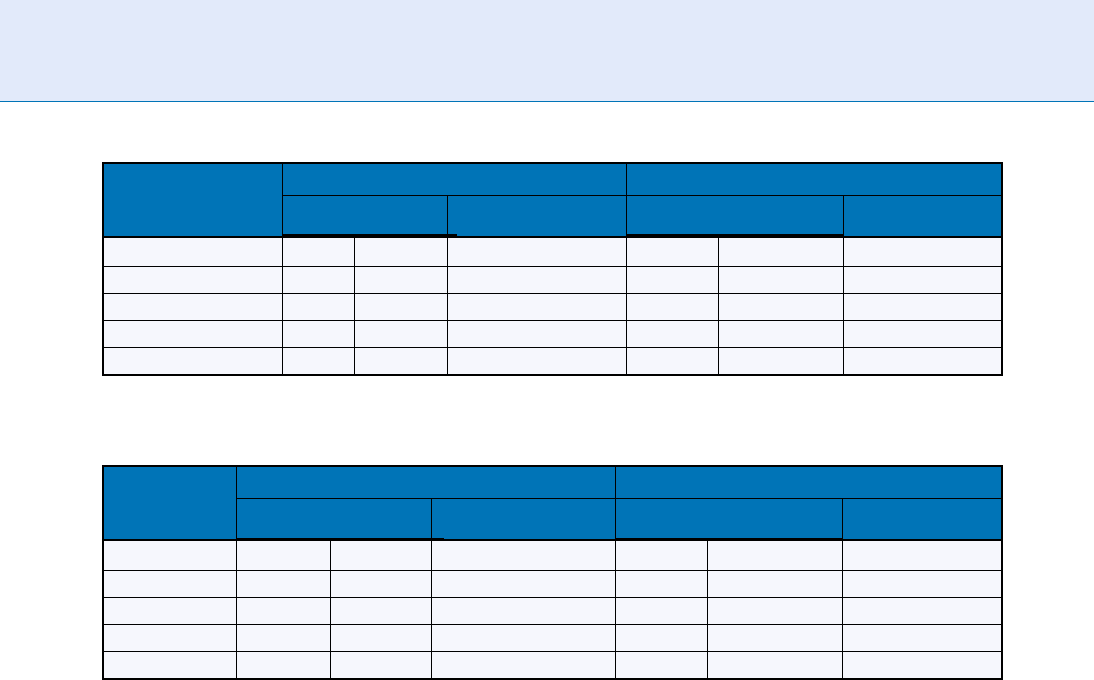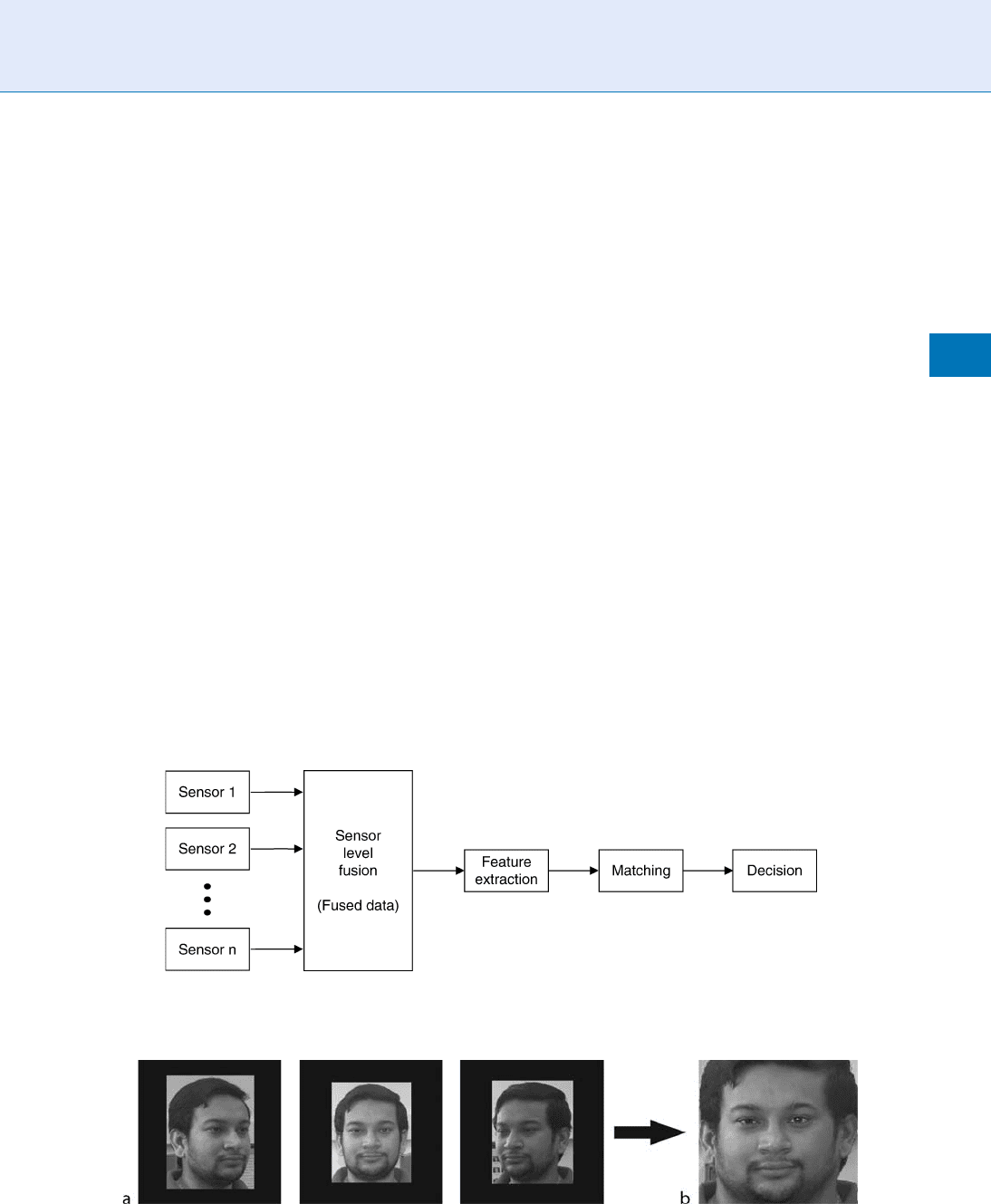Li S.Z., Jain A.K. (eds.) Encyclopedia of Biometrics
Подождите немного. Документ загружается.


2. Borda Count. The fused rank scores using Borda
count are computed as follows: m
A
=(2+3+2)=7,
m
B
= (4 + 5 + 3) = 12, m
C
= (5 + 1 + 4) = 10,
m
D
=(1+2+1)=4,m
E
= (4 + 4 + 5) = 13. Thus ,
m
D
is lowest and user D achieves highest combined
ranking (Table 1).
3. Weighted Borda Count. The fused rank scores
m
A
=(2 0.5 + 3 0.15 + 2 0.35) = 2.15. Simi-
larly rank fused scores for rest of the users can be
computed and are shown in Table 2.
4. Bayes Fuse. The prior probabilities that each of
the ranks are true (untrue), i.e., belongs to the
genuine (imposter) class, can be obtained from
the training data and are provided in the problem.
The fused rank score for user A can be computed
using (3) as follows: m
A
= log (0.1/0.9) + log (0.06/
0.94) + log (0.2/0.8) = 6.34. The rest of the fused
rank scores and t he combined rankings are dis-
played in Table 2.
Summary
In the biometrics literatures, one can find several
examples [1, 3, 4, 6] of above rank level fusion methods
to consolidate the outputs from different matchers.
Bhatnagar et al. [4] employs a variation of Borda
count method that uses partitioning of templates
to consolidate the combined ranks. Highest rank
method employed by Rautiainen and Seppanen [6], is
referred as lowest rank method since it chooses the
minimum rank from the list of dissimilarity score
instead of conventional maximum rank methods that
employ highest ranks from the list of similarity scores.
Several other variations of Borda count method have
also been developed in the literature [7]; Nenson’s
method that uses successive elimination from Borda
count that are below average Borda count or Quota
Borda method that includes the quota element in
counting ranks. However, they have not yet been inves-
tigated for their utility in the biometrics literature.
A survey of biometrics on various fusion techni-
ques [5] suggests that the rank level fusion method is
less preferred method of fusion while score level fusion
continues to be the most popular method. The rank
level fusion can be more useful in combining decisions
from a large number of biometric matchers and such
large systems has not yet been evaluated in the
biometrics literature.
References
1. Lee, Y., Lee, K., Jee, H., Gil, Y., Choi, W., Ahn, D., Pan, S.:
‘‘Fusion for multimodal biometric identification,’’ Proc.
ABVPA 2005, LNCS 3546, 1071–1079 (2005)
Fusion, Rank-Level. Table 1 Example for consolidating ranks using unsupervised rank level fusion methods
Highest rank method Borda count method
User identity
Fused rank score
Combined ranking
Fused rank score
Combined ranking
A m
A
23m
A
72
B m
B
34m
B
12 4
C m
C
11m
C
10 3
D m
D
12m
D
41
E m
E
45m
E
13 5
Fusion, Rank-Level. Table 2 Example for consolidating ranks using supervised rank level fusion methods
Weighted borda count method Bayes fuse method
User identity
Fused rank score
Combined ranking
Fused rank score
Combined ranking
A m
A
2.15 2 m
A
6.34 2
B m
B
3.8 3 m
B
10.93 4
C m
C
4.05 4 m
C
6.48 3
D m
D
1.15 1 m
D
1.47 1
E m
E
4.35 5 m
E
11.43 5
610
F
Fusion, Rank-Level

2. Aslam, J.A., Montague, M.: ‘‘Models for metasearch,’’ In: Pro-
ceedings of the 24th ACM SIGIR Conference on Research and
Development in Information Retrieval, Sep. 2001, pp. 379–381
(2001)
3. Ho, T.K., Hull, J.J., Srihari, N.: ‘‘Decision combination in multi-
ple classifier systems.’’ IEEE Trans. Pattern Anal. Mach. Intell. 16,
66–75 (1994)
4. Bhatnagar, J., Kumar, A., Saggar, N.: ‘‘A novel approach to
improve biometric recognition using rank level fusion,’’ Proc.
CVPR 2007, Minneapolis, MN, pp. 1–6, (2007)
5. Ross, A., Nandakumar, K., Jain, A.K.: Handbook of Multibio-
metrics, Springer Verlag (2006)
6. Rautiainen, M. and Seppanen, T.: ‘‘Comparison of visual
features and fusion techniques in automatic detection of
concepts from news video,’’ In: Proceedings of the IEEE Interna-
tional Conference on Multimedia and Expo., ICME 2005,
Amsterdam, pp. 932–935 (2005)
7. Dummett, M.A.E.: Principles of Electoral Reform, Oxford
University, New York (1997)
Fusion, Score-Level
ARU N ROSS
1
,KARTHIK NANDAKUMAR
2
1
West Virginia University, Morgantown, WV, USA
2
Institute for Infocomm Research A* STAR,
Fusionopolis, Singapore
Synonyms
Fusion at the confidence level; Fusion at the measure-
ment level; Match score fusion
Definition
In score-level fusion the match scores output by mul-
tiple biometric matchers are consolidated in order to
render a decision about the identity of an individual.
Typically, this consolidation procedure results in the
generation of a single scalar score which is subsequently
used by the biometric system. Fusion at this level is the
most commonly discussed approach in the biometric
literature primarily due to the ease of accessing and
processing match scores (compared with the raw bio-
metric data or the feature set extracted from the data).
Fusion methods at this level can be broadly classified
into three categories: density-based schemes, transfor-
mation-based schemes and classifier-based schemes.
Introduction
A match score is the result of comparing two feature
sets extracted using the same feature extractor. A simi-
larity score denotes how ‘‘similar’’ the two feature sets
are, while a distance score denotes how ‘‘different’’ they
are. Consequently, a high similarity score between a
pair of feature sets indicates a good match whereas
a high distance score indicates a poor match.
In score-level fusion the match scores output by
multiple biometric matchers are combined to generate
a new match score (a scalar) that can be subsequently
used by the verification or identification modules for
rendering an identit y decision (alternatively, the fusion
process may directly result in a decision). Fusion at this
level is the most commonly discussed approach in the
biometric literature primarily due to the ease of acces-
sing and processing match scores (compared with the
raw biometric data or the feature set extracted from
the data). Fusion methods at this level can be broadly
classified into three categories [1]: density-based
schemes, transformation-based schemes and classifier-
based schemes.
Density-Based Fusion schemes
Let s ¼½s
1
; s
2
; ...; s
R
denote the scores emitted by
multiple matchers, w ith s
j
representing the match
score of the jth matcher, j ¼ 1, ..., R. Further, let
the labels o
0
and o
1
denote the genuine and imposto r
classes, respectively. Then, by
▶ Bayes decision theory
[2], the probability of error can be minimized by
adopting the following decision rule. (This is known
as the Bayes decision rule or the minimum-error-rate
classification rule under the 0-1 loss function [2]).
Assign s ! o
i
if
Pðo
i
jsÞ > Pðo
j
jsÞ; i 6¼ j; and i; j ¼ 0; 1: ð1Þ
Here, the a posteriori probability Pðo
i
jsÞ, i ¼ 0,1,
can be derived from the class-conditional density func-
tion pðsjo
i
Þ using the Bayes formula, i.e.,
Pðo
i
jsÞ¼
pðsjo
i
ÞPðo
i
Þ
pðsÞ
; ð2Þ
where P(o
i
) is the a priori probability of observing
class o
i
and pð sÞ denotes the probability of encounter-
ing s. Thus , Eq. (1) can be re-written as
Fusion, Score-Level
F
611
F

Assign s ! o
i
if
pðsjo
i
Þ
pðsjo
j
Þ
> t; i 6¼ j; and i; j ¼ 0; 1 ð3Þ
where
pðsjo
i
Þ
pðsjo
j
Þ
is known as the likelihood ratio and
t ¼
Pðo
j
Þ
Pðo
i
Þ
is a predetermined threshold. The density
pðs jo
i
Þ is typically estimated from a training set of
match score vectors, using parametric or nonparametric
techniques. However, a large number of training sam-
ples are necessary to reliably estimate the joint-density
function pðsjo
i
Þ especially if the dimensionality of the
feature vector s is large. In the absence of sufficient
number of training samples (which is typically the case
when the multibiometric system is first deployed or if its
parameters are subsequently adjusted), it is commonly
assumed that the scalar scores s
i
,s
2
, ...s
R
are generated
by R independent random processes. This assumption
permits the density function to be expressed as
pðsjo
i
Þ¼
Y
R
j¼1
pðs
j
jo
i
Þ; ð4Þ
where the joint-density function is now replaced by
the product of its marginals. The marginal densities,
p(s
j
jo
i
), j ¼ 1, 2, ... R, i ¼ 0, 1, are estimated from a
training set of genuine and impostor scores
corresponding to each of the R biometric matchers.
Equation (4) results in the product rule which com-
bines the scores generated by the R matchers as,
s
prod
¼
Y
R
j¼1
pðs
j
jo
0
Þ
pðs
j
jo
1
Þ
: ð 5Þ
Kittler et al. [3] modify the product rule by further
assuming that the a posteriori probability Pðo
i
jsÞ of
class o
i
does not deviate much from its a pr iori proba-
bility P(o
i
) resulting in the sum rule:
s
sum
¼
P
R
j¼1
pðs
j
jo
0
Þ
P
R
j¼1
pðs
j
jo
1
Þ
: ð6Þ
Similar expressions can be derived for combining the
match scores using the max, min, and median rules
[1, 3]. All the aforementioned rules implicitly assume
that the match scores are continuous random variables.
Dass et al. [4] relax this assumption and represent
the univariate density functions (i.e., the marginals in
Eq. (4)) as a mixture of discrete as well as continuous
components. The resulting density functions are
referred to as generalized densities. The authors dem-
onstrate that the use of generalized density estimates
(as opposed to continuous density estimates) signi-
ficantly enhances the matching performance of the
fusion algorithm. Furthermore, they use
▶ copula
functions to model the correlation structure between
the match scores s
1
, s
2
, ..., s
R
and, subsequently, define
a novel fusion rule known as the copula fusion rule.
Transformation-Based Fusion
schemes
Density-based schemes, as stated earlier, require a large
number of training samples (i.e., genuine and impos-
tor match scores) in order to accurately estimate the
density functions. This may not be possible in most
multibiometric systems due to the time, effort, and
cost involved in acquiring labeled multibiometric
data in an operational environment. In such situations,
it may be necessary to directly combine the match
scores generated by multiple matchers using simple
fusion operators (such as the simple sum of scores or
order statistics) without first interpreting them in a
probabilistic framework. However, such an approach
is meaningful only when the scores output by the mat-
chers are comparable. To facilitate this, a score normali-
zation process is essential to transform the multiple
match scores into a common domain (it must be
noted, however, that some score normalization schemes
do require a large number of training samples as seen in
the following section). The process of score normaliza-
tion entails changing the location and the scale para-
meters of the underlying match score distributions in
order to ensure compatibility between multiple score
variables. A few of the commonly discussed score nor-
malization methods are described in this article.
The simplest normalization technique is the min–
max normalization. Min–m ax normalization is best
suited for the case where the bounds (maximum and
minimum values) of the scores produced by a matcher
are known. In this case, the minimum and maximum
scores can be easily transformed into 0 and 1, res-
pectively. However, even if the match scores are not
bounded, the minimum and maximum values for the
given set of training match scores can be estimated
prior to applying min–max normalization. Let s
i
j
denote the ith match score output by the jth matcher,
612
F
Fusion, Score-Level

i ¼ 1, 2, ..., N ; j ¼ 1, 2, ..., R (R is the number of
matchers and N is the number of match scores avail-
able in the training set). The min–max normalized
score, ns
t
j
, for the test score s
j
t
is given by
ns
t
j
¼
s
t
j
min
N
i¼1
s
i
j
max
N
i¼1
s
i
j
min
N
i¼1
s
i
j
: ð7Þ
When the minimum and maximum values are esti-
mated from the given set of match scores, this method
is not robust (i.e., the method is sensitive to outliers in
the data used for estimation). Min–max normalization
retains the original distribution of scores except for
a scaling factor and transforms all the scores into a
common range [0, 1]. Distance scores can be trans-
formed into similarity scores by subtracting the nor-
malized score from 1.
Decimal scaling can be applied when the scores
of different matchers are on a logarithmic scale. For
example, if one matcher has scores in the range [0, 10]
and the other has scores in the range [0, 1000], the
following normalization could be applied to trans-
form the scores of both the matchers to the common
[0, 1] range.
ns
t
j
¼
s
t
j
10
n
j
; ð8Þ
where n
j
¼ log
10
max
i¼1
N
s
j
i
. In the example with two
matchers where the score ranges are [0, 10] and
[0, 1000], the values of n would be 1 and 3, respectively.
The problems with this approach are the la ck of
robustness and the implicit assumption that the scores
of different matchers vary by a logarithmic factor.
The most commonly used score normali zation
technique is the z-score normalization that uses the
arithmetic mean and standard deviation of the training
data. This scheme can be expected to perform well if
the average and the variance of the score distributions
of the matchers are available. If the values of these two
parameters are not known, then they can be estimated
based on the given training set. The z-score normalized
score is given by
ns
t
j
¼
s
t
j
m
j
s
j
; ð9Þ
where m
j
is the arithmetic mean and s
j
is the standard
deviation for the jth matcher. However, both mean
and standard deviation are sensitive to outliers
and hence, this method is not robust. Z-score
normalization does not guarantee a common numer-
ical range for the normalized scores of t he different
matchers. If the distribution of the scores is not
Gaussian, z-score normalization does not preserve
the d istribution of the given set of scores. This is
due to the fa ct that mean an d standard deviation are
the optimal location and scale parameters only for a
Gaussian distribution. While mean and standard de-
viation are reasonable estimates of location and scale,
respectively, they are not optimal for an ar bitrar y
match score distribution.
The median and median absolute deviation (MAD)
statistics are less sensitive to outliers as well as points
in the extreme tails of the distribution. Hence, a nor-
malization scheme using median and MAD would be
relatively robust and is given by
ns
t
j
¼
s
t
j
med
j
MAD
j
; ð10Þ
where med
j
¼ median
N
i¼1
s
i
j
and MAD
j
¼ median
N
i¼1
js
i
j
med
j
j. However, the median and the MAD esti-
mators have a low efficiency compared to the mean
and the standard deviation estimators, i.e., when the
score distribution is not Gaussian, median and MAD
are poor estimates of the location and scale parameters.
Therefore, this normalization technique does not pre-
serve the input score distribution and does not trans-
form the scores into a common numerical range.
Cappelli et al. [5] use a double sigmoid function for
score normalization in a multibiometric system that
combines different fingerprint matchers. The normal-
ized score is given by
ns
t
j
¼
1
1þexp 2
s
t
j
t
a
1
ifs
t
j
< t;
1
1þexp 2
s
t
j
t
a
2
otherwise;
8
>
>
>
<
>
>
>
:
ð11Þ
where t is the reference operating point and a
1
and
a
2
denote the left and right edges of the region in
which the function is linear. The double sigmoid
function exhibits linear characteristics in the interval
(ta
1
, ta
2
). While the double sigmoid normaliza-
tion scheme transforms the scores into the [0, 1] inter-
val, it requires careful tuning of the parameters t,a
1
and a
2
to obtain good efficiency. Generally, t is chosen
to be some value falling in the region of overlap be-
tween the genuine and impostor score distribu tions,
and a
1
and a
2
are set so that they correspond to the
Fusion, Score-Level
F
613
F

extent of overlap between the two distributions toward
the left and right of t, respectively. This normalization
scheme provides a linear transformation of the scores
in the region of overlap, while the scores outside this
region are transformed nonlinearly. The double sig-
moid normalization is very similar to the min–max
normalization followed by the application of a two-
quadrics (QQ) or a logistic (LG) function as suggested
by [6]. When the values of a
1
and a
2
are large, the
double sigmoid normalization closely resembles the
QQ-min–max normalization. On the other hand,
the double sigmoid normalization can be made to
approach the LG-min–max normalization by assigning
small values to a
1
and a
2
.
The tanh-estimators introduced by Hampel [7] are
robust and highly efficient. The tanh normalization is
given by
ns
t
j
¼
1
2
tanh 0:01
s
t
j
m
GH
s
GH
þ 1
; ð12Þ
where m
GH
and s
GH
are the mean and standard devia-
tion estimates, respectively, of the genuine score distri-
bution as given by Hampel estimators. Hampel
estimators are based on the following influence
(c)-function:
c uðÞ¼
u 0 juj < a,
a signðuÞ a juj < b,
a signðuÞ
cjuj
cb
b juj < c,
0 jujc,
8
>
>
>
<
>
>
>
:
ð13Þ
where
signfug¼
þ1; if u 0;
1; otherwise:
ð14Þ
The Hampel influence function reduces the influ-
ence of the scores at the tails of the distribution (iden-
tified by a, b, and c) during the estimation of the
location and scale parameters. Hence, this method is
not sensitive to outliers. If many of the points that
constitute the tail of the distributions are discarded, the
estimate is robust but not efficient (optimal). On the
other hand, if all the points that constitute the tail of the
distributions are considered, the estimate is not robust
but its efficiency increases. Therefore, the parameters a,
b, and c must be carefully chosen depending on the
amount of robustness required which in turn depends
on the amount of noise in the available training data.
Mosteller and Tukey [8] introduce the biweight
location and scale estimators that are robust and effi-
cient. But, the biweight estimators are iterative in nature
(initial estimates of the biweight location and scale para-
meters are chosen, and these estimates are updated based
on the training scores), and are applicable only for Gauss-
ian data. A summary of the characteristics of the different
normalization techniques discussed in this article is
shown in Table 1. The min–max, decimal scaling
and z-score normalization schemes are efficient, but
are not robust to outliers. On the other hand, the
median normalization scheme is robust but inefficient.
Only the double sigmoid and tanh-estimators have
both the desired characteristics, namely, robustness
and efficiency.
Once the match scores output by multiple match-
ers are transformed into a common domain they can
be combined using simple fusion operators such as the
sum of scores, product of scores or order statistics (e.g.,
maximum/minimum of scores or median score).
Classifier-Based Fusion schemes
In the verification mode of operation, the match scores
generated by the multiple matchers may be input to a
trained pattern classifier, such as a neural network, in
order to determine the class label (genuine or impos-
tor). In this approach, the goal is to directly estimate
the class rather than to compute an intermediate
scalar value. Classifier-based fusion schemes assume
the availability of a large representative number of
genuine and impostor scores during the training
phase of the classifier when its parameters are com-
puted. The component scores do not have to be trans-
formed into a common domain prior to invoking the
classifier.
Fusion, Score-Level. Table 1 Summary of score
normalization techniques.
Normalization technique Robustness Efficiency
Min–max No High
Decimal scaling No High
Z-score No High
Median and MAD Yes Moderate
Double sigmoid Yes High
Tanh-estimators Yes High
614
F
Fusion, Score-Level

In the biometric literature several classifiers have
been used to consolidate the match scores of multiple
matchers. Brunelli and Falavigna [9] use a HyperBF
network to combine matchers based on voice and face
features. Verlinde and Cholet [ 10] compare the relative
performance of three different classifiers, namely, the
k-Nearest Neighbor classifier using vector quantiz a-
tion, the decision tree classifier, and a classifier based
on the logistic regression model w hile fusing the match
scores originating from three biometric matchers.
Experiments on the M2VTS database show that the
total error rate (sum of the false accept and false reject
rates) of the multimodal system is an order of magni-
tude less than that of the individual matchers. Chatzis
et al. [11] use classical k-means clustering, fuzzy clus-
tering and median radial basis function (MRBF) algo-
rithms for fusion at the match score level. The
proposed system combines the output of five different
face and voice matchers. Each matcher provides a
match score and a quality metric indicating the reli-
ability of the match score. These values are concate-
nated to form a ten-dimensional vector that is input to
the classifiers. Ben-Yacoub et al. [12] evaluate a num-
ber of classification schemes for fusion including sup-
port vector machine (SVM) with polynomial kernels,
SVM with Gaussian kernels, C4.5 decision trees, mul-
tilayer perceptron, Fisher linear discriminant, and
Bayesian classifier. Experimental evaluations on the
XM2VTS database consisting of 295 subjects suggest
the benefit of score level fusion. Bigun et al. [13]
propose a novel algorithm based on the Bayesian clas-
sifier that takes into account the estimated accuracy of
the individual classifiers (i.e., matchers) during the
fusion process. Sanderson and Paliwal [14] use a sup-
port vector machine (SVM) to combine the scores of
face and speech experts. In order to address noisy
input, they design structurally noise-resistant classi-
fiers based on a piece-wise linear classifier and a mod-
ified Bayesian classifier.
Summary
In a multibiometric system, fusion at the score level
offers the best tradeoff between amount of information
that is available and ease of fusion. Hence, score level
fusion is typically adopted by most multibiometric
systems. Although a wide variety of score level fusion
techniques have been proposed in the literature,
these can be grouped into three main categories, viz.,
density-based, transformation-based and classifier-
based schemes. The performance of each scheme
depends on the amount and quality of the available
training data. If a large number of match scores is
available for training the fusion module, then density-
based approaches such as the likelihood ratio test can
be used. Estimating the genuine and impostor distri-
butions may not always be feasible due to the limited
number of training samples that are available. In such
cases, transformation-based schemes are a viable alter-
native. The nonhomogeneity of the match scores pre-
sented by the diffe rent matc hers raises a number of
challenges. Suitable score normali zation schemes are
essential in order to transform these matc h scores into
a comparable domain. The sum of scores fusion meth-
od with simple score normalization (such as min–
max) represents a commonly used transformation-
based scheme. Classification-based fusion schemes
consolidate the outputs of different matchers into a
single vector of scores which is input to a trained
classifier. The classifier then determines if this vector
belongs to the ‘‘genuine’’ or ‘‘impostor’’ class.
Related Entries
▶ Fusion, Qualit y-Based
▶ Fusion, User-Specific
▶ Multibiometrics
References
1. Ross, A., Nandakumar, K., Jain, A.K.: Handbook of Multibio-
metrics. 1st edn. Springer, New York, USA (2006)
2. Duda, R.O., Hart, P.E., Stork, D.G.: Pattern Classification. Wiley,
New York (2001)
3. Kittler, J., Hatef, M., Duin, R.P., Matas, J.G.: On combining
classifiers. IEEE Trans. Pattern Analy. Mach. Intell. 20, 226–239
(1998)
4. Dass, S.C., Nandakumar, K., Jain, A.K.: A principled approach to
score level fusion in multimodal biometric systems. In: Proceed-
ings of Fifth International Conference on Audio- and Video-based
Biometric Person Authentication (AVBPA), pp. 1049–1058. Rye
Brook, USA (2005)
5. Cappelli, R., Maio, D., Maltoni, D.: Combinin g fingerpri nt
classifiers. In: Proceedings of First Internat ional Workshop
on Multipl e Classifier Systems, pp. 351–3 61. Cagliari, Italy
(2000)
Fusion, Score-Level
F
615
F

6. Snelick, R., Uludag, U., Mink, A., Indovina, M., Jain, A.K.: Large
Scale evaluation of multimodal biometric authentication using
state-of-the-art systems. IEEE Trans. Pattern Analy. Mach. Intell.
27, 450–455 (2005)
7. Hampel, F.R., Rousseeuw, P.J., Ronchetti, E.M., Stahel, W.A.:
Robust Statistics: The Approach Based on Influence Functions.
Wiley, New York (1986)
8. Mosteller, F., Tukey, J.W.: Data Analysis and Regression: A Sec-
ond Course in Statistics. Addison-Wesley, Reading, MA, USA
(1977)
9. Brunelli, R., Falavigna, D.: Person Identification using multiple
cues. IEEE Trans. Pattern Analy. Mach. Intell. 17, 955–966 (1995)
10. Verlinde, P., Cholet, G.: Comparing decision fusion paradigms
using k-NN based classifiers, decision trees and logistic regres-
sion in a multi-modal identity verification application. In: Pro-
ceedings of Second International Conference on Audio- and
Video-Based Biometric Person Authentication (AVBPA), pp.
188–193. Washington D.C., USA (1999)
11. Chatzis, V., Bors, A.G., Pitas, I.: Multimodal decision-level fu-
sion for person authentication. IEEE Trans. Syst. Man Cybernet.
Part A: Syst. Humans 29, 674–681 (1999)
12. Ben-Yacoub, S., Abdeljaoued, Y., Mayoraz, E.: Fusion of face and
speech data for person identity verification. IEEE Trans. Neural
Networks 10, 1065–1075 (1999)
13. Bigun, E.S., Bigun, J., Duc, B., Fischer, S.: Expert Conciliation for
multimodal person authentication systems using bayesian sta-
tistics. In: First International Conference on Audio- and Video-
based Biometric Person Authentication (AVBPA), pp. 291–300.
Crans-Montana, Switzerland (1997)
14. Sanderson, C., Paliwal, K.K.: Information Fusion and Person
Verification Using Speech and Face Information. Research
Paper IDIAP-RR 02-33, IDIAP (2002)
Fusion, Sensor-Level
AFZEL NOORE,RICHA SINGH,MAYANK VASTA
West Virginia University, Morgantown, WV, USA
Synonyms
Fusion, data level; Fusion, image level
Definition
Sensor level fusion combines raw biometric informa-
tion that can account for inter-class and intra-class
variability and facilitate decision making based on the
fused raw information. A typical sensor level fusion
algorithm first integrates raw biometric data either
obtained from different viewpoints (for example,
mosaicing several fingerprint impressions) or obtained
from different sensors (for example, multimodal bio-
metric images). The integrated data is then processed
and discriminatory biometric features are extracted for
matching. This level of fusion can be operated in both
verification and
▶ identification modes. Few examples
of sensor level fusion are: fingerprint mosaicing, multi-
spectral face image fusion, and multimodal biometric
image fusion.
Introduction
The concept of biometric information fusion is moti-
vated from classical multi-classifier systems that com-
bine information from different sources and represent
using a single entity. Performance driven systems that
use multiple biometric characteristics are known in
multibiometric system [1]. These systems have several
advantages over unimodal biometric systems such as
tolerance to noise and malfunction, universality, and
improved accuracy. Multibiometric systems are broadly
classified into five levels of fusion.
1. Sensor level fusion. Raw data obtained directly from
the sensors are fused without any feature extraction
and represented as a single unit. This level of fusion
is also known as data level fusion or image level
fusion (for image based biometrics).
2. Feature level fusion . Data obtained from different
sensors are first subjected to feature extraction
algorithms and the feature sets are combined to
generate a new feature vector which is subsequently
used for recognition.
3. Match score level fusion. Features extracted from
individual biometric modalities are first matched
to compute the corresponding match scores. Match
scores obtained from different biometric systems
are then combined to generate a fused match score.
4. Decision level fusion. Decisions of individual
biometric classifiers are fused to compute a com-
bined decision. This level of fusion is also known
as abstract level fusion because it is used when there
is access to only decisions from individual classifier’s.
5. Rank level fusion. With identification systems, rank
level fusion involves combining identification ranks
obtained from multiple unimodal biometrics. The
output of rank level fusion is a consolidated rank
that is used for final decision.
616
F
Fusion, Sensor-Level

This article focuses on sensor level fusion and pro-
vides a comprehensive overview of the methodologies
involved. In this level of fusion, first the raw data
obtained from the sensors are combined to generate a
fused data. An application oriented feature extraction
algorithm is then used to compute the features from
the fused data and matching is performed. Figure 1
illustrates the basic concept of sensor level fusion.
Sensor level fusion can be broadly classified into
three categories: (1) single sensor multi-samples, (2)
multi-sensor, and (3) multimodal. This article is
organized to accentuate various algorithms proposed
in each fusion category.
Sensor Level Fusion: Single Sensor Multi-
Samples
In these systems, multiple samples of a single bio metric
modality are acquired using a single sensor and the
information is combined to account for variations that
can occur in a biometric modality. For example, as
shown in Fig. 2, different profiles of a face image can
be combined to obtain a fused representation of face
image that can address the challenges due to pose
variations [2]. In this categ ory of sensor fusion,
image
▶ mosaicing techniques are used for integrati ng
information obtained from several impressions or v iew
points, to augment the biometric content and to en-
hance the verification/identification performance.
Singh et al. [2] describe the concept of mosaicing in
biometrics as an exercise in information fusion when
multiple images of a subject’s biometric information
are fused into a single entity in the image domain
itself. Therefore, this could be viewed as fusion at the
sensor level.
Mosaicing was first introduced in biometrics by
Ratha et al. [3]. A rolled fingerprint image is generated
from several partial fingerprint images using segmen-
tation and blending algorithms assuming that the
partial fingerprints are spatially registered. The per-
formance of this fingerprint mosaicing algorithm is
evaluated using different blending algorithms. The
mosaicing algorithm generates rolled fingerprint image
that is very close to the ground truth and improves
the minutiae count that is useful for recognition. Fur-
ther, Jain and Ross [4] proposed the use of iterative
closest point algorithm to seamlessly register the ridges
of two fingerprint images and to generate a composite
fingerprint image. Recently, Ross et al. [5] employed
thin-plate splines ( TPS) to model the non-linear
deformation in fingerprint imag es and integrate it
Fusion, Sensor-Level. Figure 1 Basic concept of sensor level fusion.
Fusion, Sensor-Level. Figure 2 Combining profile and frontal face images using mosaicing technique. (a) Profile and
frontal face images and (b) Mosaiced face image.
Fusion, Sensor-Level
F
617
F

in the mosaicing process. This algorithm first aligns
two fingerprint images using coarse alignment (affine
model) followed by TPS based fine alignment. Once
the fingerprint images are registered, a mosaiced fin-
gerprint image is obtained by applying simple pixel
averaging based blending method.
Mosaicing has also been applied to face biometrics.
Yang et al. [ 6] describe an algorithm to create pano-
ramic face mosaics. The acquisition system consists of
five cameras that simultaneously obtains five different
views of a subject’s face. Based on the manually marked
control points, the algorithm uses a series of linear
transformations and smoothing operations on com-
ponent images to generate a face mosaic. Unlike fin-
gerprint mosaicing, face mosaicing requires specific
feature extraction algorithm. Two different schemes
to represent the panoramic image were proposed: one
in the spatial domain and another in the frequency
domain. Experimental evaluation on a database of
12 individuals shows that the face mosaicing algorithm
improves identification accuracy in both the spatial
and frequency domains. In [7], Liu and Chen describe
a face mosaicing algorithm in which the human head is
approximated with a 3D ellipsoidal model. The face, at
a certain pose, is v iewed as a 2D projection of this 3D
ellipsoid. All 2D face images of a subject are projected
onto this ellipsoid via geometrical mapping to form a
texture map which is represented by an array of local
patches. Matching is accomplished by adopting a prob-
abilistic model to compute the distance of patches
from an input face image. An identification accuracy
of 90% on different databases has been reported.
In [2], Singh et al. proposed a face mosaicing algo-
rithm that can perform mosaicing in v isible spectrum
domain as well as in short wave infrared domain.
The algorithm first registers the component face
images using two stage registration algorithm and
then a face mosaic is generated using multi-resolution
splines based blending algorithm. Facial features are
encoded using a generic feedforward hierarchical
model-based feature extraction algorithm that extrac ts
local facial features using the fundamentals of a
biological visual system. Experiments conducted
on three different face databases indicate that the pro-
posed face mosaicing algorithm offers significant ben-
efits by accounting for pose variations that are
commonly observed in face images. Moreover, the
mosaicing algorithm requires less time for matching
compared to the score level fusion and also reduces the
memory requirements.
Sensor Level Fusion: Multi-Sensors
In this category of sensor level fusion, multiple samples
of a single biometric modality are obtained using
multiple sensors and the information is combined
such that the fused multi-sensor information improves
the recognition performance. In general, the informa-
tion obtained from multiple sensors are complementary
to each other and can account for the intra-class varia-
bility. For example, as shown in Fig. 3, multi-spectral
face images obtained using visible spectrum and infra-
red sensors can be fused to minimize the intra-class
variations due to illumination and expression.
Multi-spectral face image fusion is the classical
model for this level of fusion. Face recognition algo-
rithms generally use visible spectrum images for rec-
ognition because the reflectance property yields a
Fusion, Sensor-Level. Figure 3 Multi-spectral face image fusion. (a) Visible and infrared spectrum images and
(b) Fused image.
618
F
Fusion, Sensor-Level

clear representation of facial features to differentiate
between two individuals. However, visible spectrum
images also possess several other properties which
affect the performance of recognition algorithms. For
example, changes in lighting affect the representation
of visible spectrum images and can influence feature
extraction. Other variations in facial appearance such
as hairs, wrinkles, and expression are also evident in
visible spectrum images and these variations increase
the false rejection rate of face recognition algorithms.
To address the challenges posed by visible spectrum
images, researchers have used infrared images for face
recognition [8]. Among all infrared spectrum images,
long wave infrared (LWIR) images possess several
properties that are complementary to visible images.
Visible spectrum captures the electromagnetic energy
in the range 0.4–0.7mm, whereas long wave infrared or
thermal images are captured in the range of 8–12mm.
Thermal images represent the heat pattern of the object
and are invariant to illumination and expression. Face
images captured in long wave infrared spectrum have
less intra-class variation and help to reduce the false
rejection rate of recognition algorithms. These proper-
ties of long wave infrared and visible images can be
combined to improve the performance of face recogni-
tion algorithms.
In literature, researchers have proposed several
multi-spectral face image fusion algorith ms [8]. Bebis
et al. [9] proposed an image fusion algorithm in wave-
let domain using genetic algorithm. In this algorithm,
multi-spectral face images are first transformed into
wavelet domain and a multiresolution representation
is obtained. Then, a genetic algorithm is used to select
the most appropriate wavelet coefficients at pixel level.
Finally, inverse
▶ wavelet transform is applied to gen-
erate a fused face image and Eigenface based algorithm
is used fo r feature extraction and matching. The genetic
fusion algorithm suffers from making a good choice of
fitness function. Kong et al. [10] proposed a wavelet
based multi-spectral face image fusion algorithm in
which the visible and infrared spectrum images are
first registered using affine transformation. An empiri-
cal weighting scheme is then applied on the registered
multi-spectral face images in wavelet domain to obtain
the composite face image. Although the algorithm
is straightforward, the generic empirical weig hting
scheme is not sufficient to address the inter-class and
intra-class variability in face images. Recently, Singh
et al. [11] proposed a 2n-granular support vector
machine (2n-GSVM ) based multi-spectral face image
fusion algorithm. This algorithm first registers multi-
spectral face images using mutual information based
registration algorithm. Then, a 2n-GSVM learning
scheme is invoked in wavelet domain to learn the
properties of the multi-spectral face images at different
resolution and granularity levels, determine optimal
information and combine them to generate a fused
image. Finally, texture features are extracted from the
fused image for recognition. Experimental results show
that 2n-GSVM based fusion algorithm can address the
challenges due to illumination, expression, and occlu-
sion variations. This algorithm provides improved
verification accuracy (>94% ) compared to other
image fusion schemes.
Another example of sensor level fusio n with multi-
ple sensors is fusing 2D and 3D facial information.
Lu et al. [12] describe a semi-automatic sensor level
fusion algorithm that integrates range and texture fea-
tures for improved face recognition performance.
Combining 3D shape information with registered 2D
texture information using iterative closest point algo-
rithm improves the face identification performance.
The authors report that the algorithm is robust to
arbitrary view, lighting, and facial appearance. How-
ever, the algorithm is computationally expensive and
suffers due to non-rigid variations.
Sensor Level Fusion: Multimodal
In most of the multimodal biometric systems, such as
bimodal system with face and fingerprint, fusion is
performed at match score level or decision level. Very
limited research is undertaken to perform sensor level
fusion in a multimodal system. In this category of
sensor level fusio n, multimodal biometric images are
fused to address issues such as universality, memory
storage, small sample size recognition, and recognition
performance. Further, an efficient sensor level fusion
algorithm has advantages due to the availability of
fused raw information from where the representative
composite biometric features can be extracted and
used for matching. The main challenge lies in develop-
ing fusion algorithm that can account for inter-class
and intra-c lass variability in multimodal biometric
images. An example of multimodal biometric image
fusion is shown in Fig. 4.
Fusion, Sensor-Level
F
619
F
